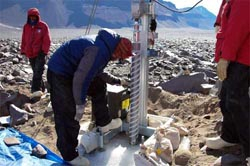Update
2008 Expedition You can also read Jackie's journals from her expedition in 2008, also with Dr. Marchant here.
What Are They Doing?
 Setting up a drill site in the Dry Valleys, Antarctica
Setting up a drill site in the Dry Valleys, Antarctica
A small team of earth scientists and engineers used a specialized drill to reach buried ice deposits in the Dry Valleys region of Antarctica. Stagnant and/or slow-moving debris-covered glaciers may contain ice several million years in age. By comparison, the oldest ice yet cored from the East Antarctic Ice Sheet is approximately 1 million years old. As a result, these buried ice deposits hold an ancient archive of Earth's past atmospheric conditions. Each ice core enabled the research team to gain access to a reliable record of atmospheric and climatic change extending back for many millions of years, making it by far the oldest ice yet known on this planet.
In addition to drilling for ancient ice, the team worked in the Dry Valleys to seek a better understanding of surface processes that play a critical role in maintaining and/or modifying buried glacier ice. Despite their age and potential to register long-term climate change, there has been surprisingly little research on the geologic and geomorphologic processes that both preserve and modify debris-covered glaciers in Antarctica. In addition, the cold polar desert of the Dry Valleys is one of the most Mars-like climatic environments and landscapes on Earth, serving as a proxy for very ancient ice buried on Mars and providing insight into Martian history and the potential for life on Mars.
Where Are They?
The team flew to McMurdo Station on a C-17 aircraft and then to various field sites within the Dry Valleys via helicopter. Transportation around field sites was on foot, up to 8 miles per day. The field sites were rustic with each individual sharing a Scott tent for sleeping and all members sharing a dedicated cook tent for meals.
The McMurdo Dry Valleys are located on the western coast of McMurdo Sound and form the largest relatively ice-free area on the Antarctic continent. The perennially ice-covered lakes, frozen alpine glaciers, and extensive areas of exposed soil and permafrost within the McMurdo Dry Valleys are subject to low temperatures, limited snowfall, and salt accumulation.



